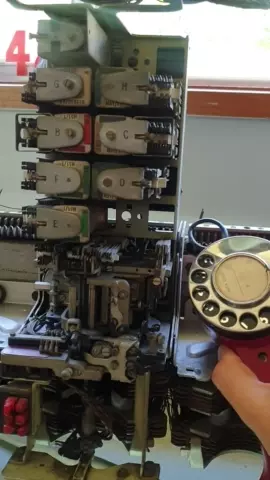A totally complete history and not just something I learned from a fellow phone nerd who’s been around a lot longer than me...
In the early days of telephony voice calls were made by signaling to an operator who would connect your call.
Around the turn of the century the first “automatic” exchanges began to open. This meant that a subscriber could complete their own call, by directly dialing the digits of the party the want to speak to, and getting through, without a human operator “plugging up” the call.
The first type of switches used to provide “automatic” exchange capability were Strowger type switches, they translated the pulses from a rotary dial phone into physical movements on a switch to find and select the line you want.

People who were born before touch tone phones can tell you about how you can dial a phone number without using the dial at all. By mashing the hook switch really quickly. If you want to dial a 3 you mash the hook switch 3 times, then wait a second, then to dial a 5 smash the hook switch 5 times, etc, etc.
A quirk of this is that higher numbers, are harder to dial, you just need one pulse of the hook switch in a second to dial a 1, but you need 10 pulses to dial a 0. This means a phone dial that’s running too slow can dial the lower digits, but not the higher digits, as it can’t pulse out the required number of pulses is the time allotted (a smidge over 1 second per digit).
Initially exchanges only connected local calls, but with the introduction of Subscriber Trunk Dialing (STD), subscribers could call from one exchange to another without an operator.
This led to national dialing plans being developed, ensuring uniqueness of numbers across the whole of the phone network, and where possible, lower numbers were used, Australia for example has area codes 02, 03, 07 and 08 (with the majority of the population living in the 02 and 03 area codes).
Now imagine you’re the government owned phone company, tasked with creating a single number for emergency services, 123, 111, etc, etc, are all taken up, as these are the most reliable numbers to dial and were used long ago.
Instead you go to the other end, the UK with 999 and Australia with 000 (911 is a different kettle of fish).
Except in New Zealand.
111 was specifically chosen to be similar to Britain’s 999 service, but NZ has some odd peculiarities.
The NZ dials are identical to the standard dial except for the finger plate label.
With pulse dialing, New Zealand telephones pulse “in reverse” to the rest of the world.
Dialing 0 on a phone in the rest of the world, sent ten pulses down the line.
But dialing a 0 on a phone in NZ sent one pulse down the line.
The same for all the other numbers.
The phones weren’t different – Just the labels.
Hence the reason why ‘Emergency’ services were on 111 in NZ (but actually pulsed 999) as the exchanges originated in those days from the UK where 999 was (and still is 999).
In the early years of 111, the telephone equipment was based on British Post Office equipment, except for this unusual orientation. Therefore, dialing 111 on a New Zealand telephone sent three sets of nine pulses to the exchange, exactly the same as the UK’s 999.
My father was an expert with these step by step exchanges. He could just listen to it to determine if it was working properly.
I remember going in there when I was young seeing rows of these working. It was pretty amazing.